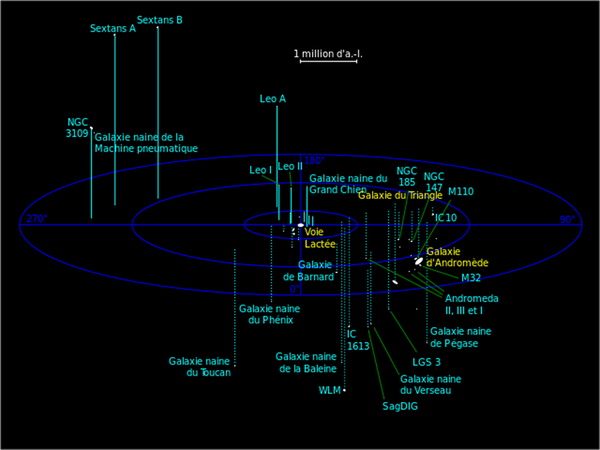
Image description: Map of the major galaxies of the Local Group, showing their relative positions around the two dominant galaxies: the Milky Way, Andromeda, and the Triangulum Galaxy. Image source: NASA/Hubble – Public domain.
Galaxy clusters are the largest gravitationally bound structures in the universe. They assemble into superclusters, and our own galaxy, the Milky Way, is part of the Local Group, which contains about forty galaxies. Furthermore, the Milky Way belongs to an even larger supercluster of galaxies: the Laniakea Supercluster. This supercluster spans nearly 500 million light-years and contains over 100,000 galaxies.
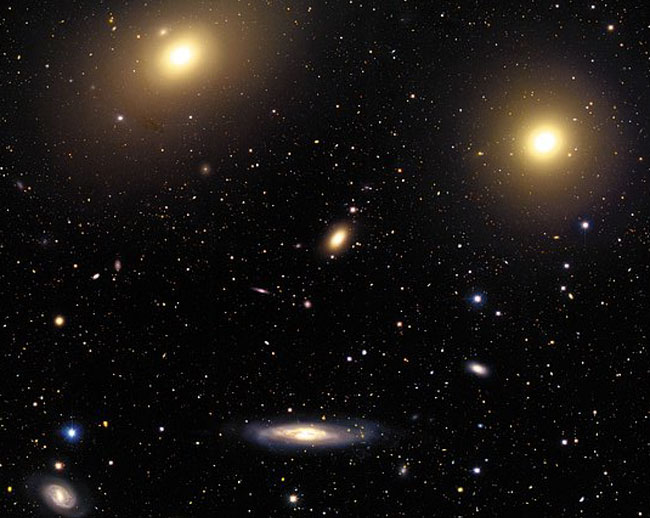
Image description: The Virgo Cluster is a large galaxy cluster located at a distance of 15 to 22 Mpc (~48.9 to 71.8 million light-years). Discovered by Charles Messier in 1781, he mapped many of its largest galaxies, including the giant galaxy M87. This cluster is at the center of the Virgo Supercluster, which includes the Local Group and therefore the Milky Way. It lies in the Virgo constellation, with an angular diameter of about 8 degrees, and contains roughly 1,300 to 2,000 galaxies, many visible with a small telescope. The precise distance to the cluster is uncertain; the best current estimates, based on Cepheids observed with the Hubble Space Telescope, give an average distance of about 20 Mpc (65 million light-years). The cluster is an irregular aggregation of at least three subclusters centered on M87, M86, and M49. The largest subcluster is centered on M87, with a mass of approximately 10^14 solar masses, about an order of magnitude greater than the other two. Image source: NASA/Hubble.

Image description: The Coma Cluster, also known as the Berenices Hair Cluster (Abell 1656), is a vast galaxy cluster containing over 1,000 identified galaxies. Located about 99 million light-years from Earth, it is part of the Berenices Hair Supercluster. The ten brightest spiral galaxies in this cluster have apparent magnitudes between 12 and 14 and can be observed with amateur telescopes over 200 mm in diameter. The central region is dominated by two giant elliptical galaxies: NGC 4874 and NGC 4889. Image source: NASA/Hubble.
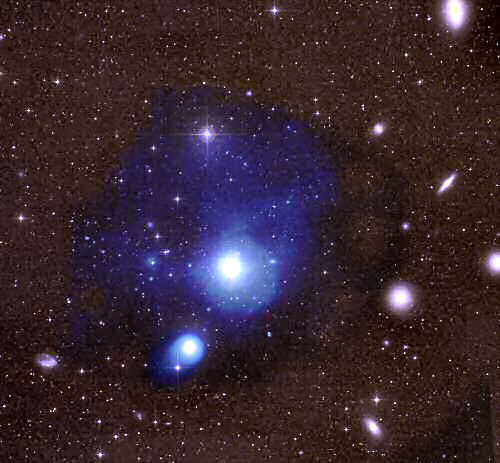
Image description: The Fornax Cluster is a relatively nearby galaxy group, about 65 million light-years from Earth, mainly located in the constellation Fornax. With over 600 member galaxies, it is the second richest galaxy cluster within 100 million light-years of our galaxy (after the much larger Virgo Cluster). Two elliptical galaxies dominate its center: NGC 1399 and NGC 1404. These galaxies contain much older stars than the picturesque spiral galaxies and are held together by gravity. Another galaxy, NGC 1427A, is in the lower-left corner of the image. This irregular galaxy is moving rapidly toward the cluster core and will eventually undergo gravitational interactions with other galaxies, leading to its disintegration. The Fornax Cluster is a fascinating object for studying galactic dynamics and dark matter. Image source: NASA/Hubble.
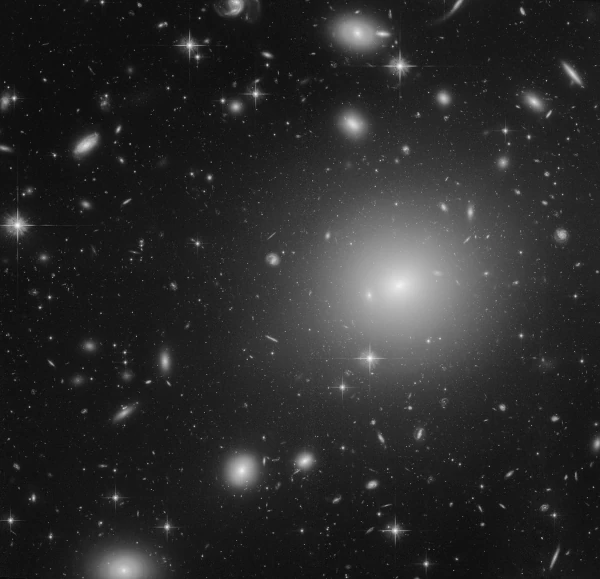
Image description: The Shapley Supercluster, also called the Shapley Concentration (SCl 124), is a galaxy supercluster in the constellation Centaurus. It lies approximately 650 million light-years away (redshift z = 0.046). Discovered by Harlow Shapley in 1936, it contains roughly 76,000 galaxies brighter than 18th apparent magnitude. This supercluster is notable for its large linear size, high population, and elongated shape. Today, it is considered the core of the Shapley Supercluster. In 1989, Somak Raychaudhury of Cambridge University re-identified the entire supercluster using UK Schmidt Telescope plates and automated plate measurements (APM). The Shapley Supercluster is also linked to the Great Attractor, a mass concentration in the same direction toward Centaurus. Image source: Judy Schmidt.
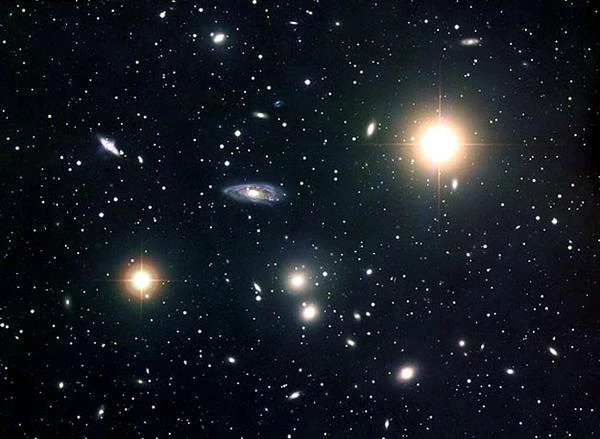
Image description: The Hydra Cluster (Abell 1060) is a galaxy cluster located in the Hydra constellation. It contains 157 bright galaxies. The cluster spans a width of 10 million light-years and contains a large amount of dark matter. Among its members, NGC 3311 is the brightest galaxy, with a magnitude around 12. NGC 3309 and NGC 3311 are elliptical galaxies, while NGC 3312 is a spiral galaxy with a diameter of 150,000 light-years. Image source: David Malin.
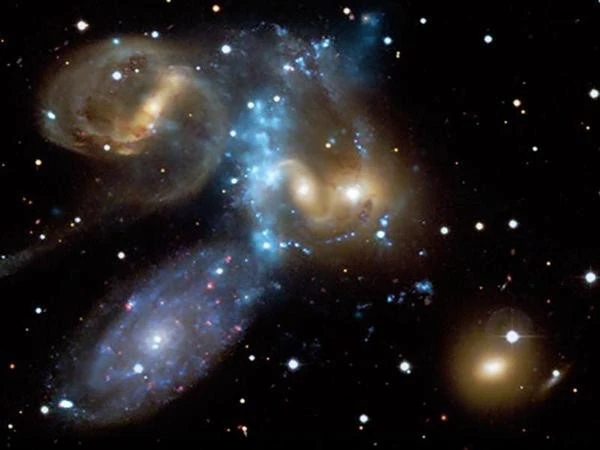
Image description: Stephan's Quintet, located 290 million light-years away in the Pegasus constellation, is an iconic group of five galaxies (four of which are gravitationally interacting), discovered in 1877. In this system, NGC 7318B collides with the others at nearly 3 million km/h, providing a natural laboratory to study galactic mergers and their effects: tidal distortions, gas heating (observed in X-rays by Chandra), and starburst events. While visible with an amateur telescope, its spectacular details—such as the intergalactic shock wave—were revealed by the James Webb in 2022, making it a major target to understand cluster evolution. Fun fact: the fifth galaxy, NGC 7320, is actually seven times closer to us, coincidentally superimposed! Image source: NASA/Hubble.
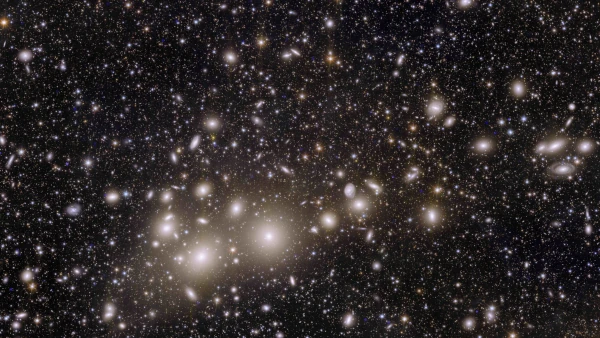
Image description: The Perseus Cluster (Abell 426) is a galaxy cluster in the Perseus constellation. Its velocity relative to the cosmic microwave background is 4,995 ± 60 km/s, corresponding to a Hubble distance of 73.7 ± 5.3 Mpc (~240 million light-years). It is part of the Perseus-Pisces Supercluster. The cluster contains about 190 galaxies out of roughly 1,000 galaxies in the supercluster. It is the brightest galaxy cluster in X-rays. The X-ray emission comes from the thermal emission of the cluster's gas (plasma), concentrated in its center. The radio galaxy NGC 1275 (Perseus A, also known as 3C84) is the brightest galaxy in the cluster. It is a cD-type galaxy and one of the most massive in the universe. NGC 1265 (3C 83.1B) is another interesting radio galaxy, with relativistic radio jets bending over hundreds of kiloparsecs. The Perseus Cluster is relatively nearby, allowing detailed observations of its X-ray emission using the Chandra space telescope. Image source: ESA.

Image description: The Seyfert Sextet is a galaxy group located in the Serpens constellation, about 200 million light-years (60 Mpc) from the Milky Way. Although it appears to contain six galaxies, only five are actually interacting. Seyfert is one of the most compact galaxy groups known, spanning less than 100,000 light-years (30 kpc), roughly the width of the Milky Way. Each interacting galaxy has a diameter of no more than 35,000 light-years (10.75 kpc). Image source: NASA/ESA.

Image description: Together with the Leo Cluster (Abell 1367), the Coma Cluster is one of the two major clusters forming the Coma Supercluster. The Coma Cluster is spherical, very dense at its center, contains over 1,000 identified galaxies, and is located 300 million light-years away along with the Virgo Cluster in the Virgo constellation. Image source: NASA/Hubble.

Image description: The Hubble Space Telescope amazes us again with Abell 2744, the most massive and deepest galaxy cluster ever imaged. This image shows some of the youngest galaxies ever detected in the deep universe. The immense gravity of Abell 2744 warps space, so the galaxies behind it appear magnified and distorted, like through a lens. The most distant galaxies are about 12 billion years old, formed shortly after the Big Bang. In this exposure, Hubble reveals nearly 3,000 background galaxies mixed with hundreds of foreground galaxies in the cluster. The distant galaxies appear bright, stretched, and duplicated due to Abell 2744's gravitational field. Gravitational lensing amplifies background galaxies by 10 to 20 times, making them brighter and larger than they actually are. Most would be invisible without lensing. In 2022, the James Webb revealed unprecedented details, including primordial galaxies only 450 million years after the Big Bang. The cluster acts as a natural lens, magnifying background light up to 20 times, showing galaxies 100 times less massive than the Milky Way and offering insight into early star formation. Image source: STScI/NASA/ESA/CSA.
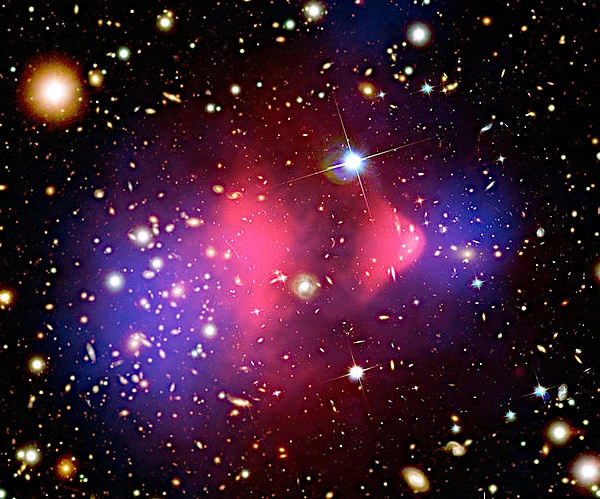
Image description: The Bullet Cluster, located 3.7 billion light-years away, is the result of a violent collision between two galaxy clusters. Combined observations from Chandra (pink: hot gas) and Hubble (blue: mass distribution via gravitational lensing) provided the first direct evidence of dark matter. Intergalactic gas (visible in X-rays) slowed during the collision, while dark matter (deduced from gravitational distortions) continued, revealing a clear separation between ordinary and dark matter. This cluster is a cosmological laboratory to study dark matter properties and test the ΛCDM model. Image source: NASA/CXC/CfA/M.Markevitch et al. (X-ray) + NASA/STScI (optical) – Public domain.
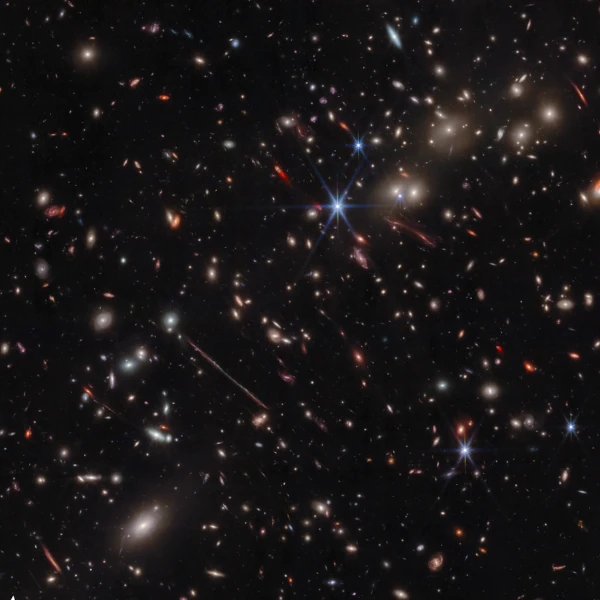
Image description: Nicknamed "El Gordo" ("the fat one" in Spanish), this cluster has a mass of 3 million billion suns and results from the merger of two clusters at speeds of several million km/h. Discovered in 2011 by Chandra and the Very Large Telescope, it surprised astronomers: its mass and temperature (200 million °C) are too high for standard model predictions. Observations suggest it may represent an extreme case of hierarchical formation or indicate gaps in our understanding of cosmology. Image source: NASA/CXC/Rutgers/J.Hughes et al.
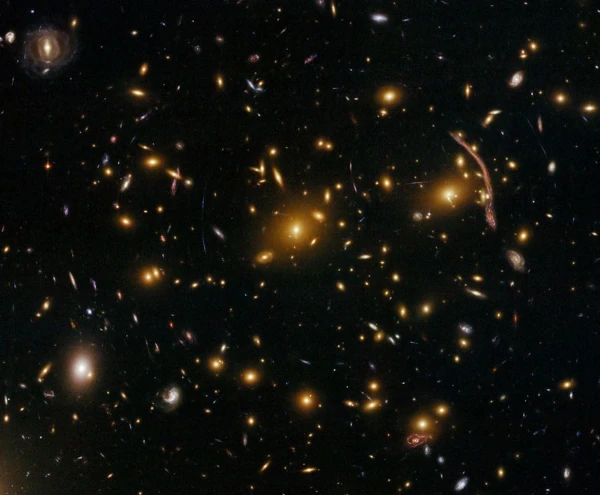
Image description: Located 4 billion light-years away, Abell 370 is famous for its giant arcs – distorted images of background galaxies stretched by the cluster’s gravity. The brightest arc, nicknamed "the Dragon", is a spiral galaxy five times farther away than the cluster itself. Hubble and JWST data allow detailed study of these galaxies, impossible without lensing effects. Image source: NASA/Hubble.
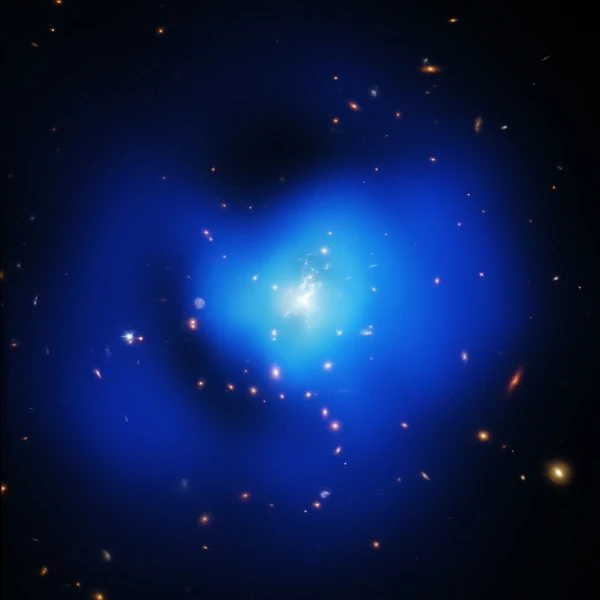
Image description: The Phoenix Cluster holds the record for star formation among massive clusters, at a rate 500 times that of the Milky Way. Its central galaxy, surrounded by a cold gas halo, challenges theories of cluster cooling. X-ray observations (Chandra) show gas filaments extending 200,000 light-years, where stars form at a frenzied pace. Image source: X-ray: NASA/CXC/MIT/M.McDonald et al.; Optical: NASA/STScI
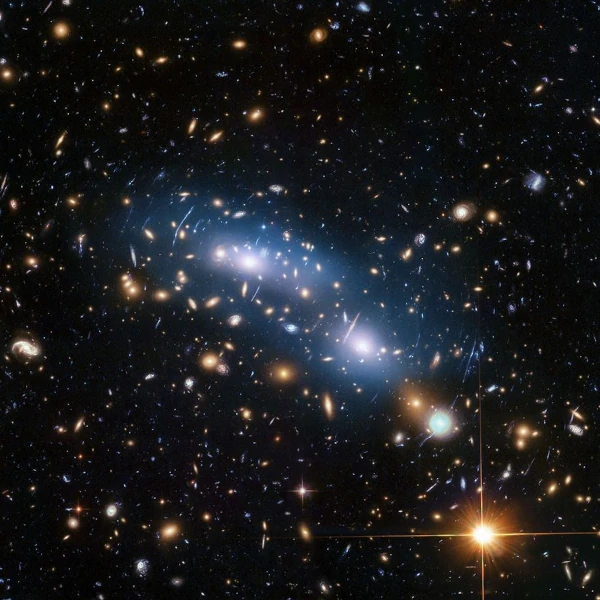
Image description: This cluster, 4.3 billion light-years away, allowed creation of a detailed dark matter map by analyzing distortions of 100 background galaxies. In 2014, astronomers observed four images of the same supernova (named Refsdal), predicted by lensing models. JWST has since identified dwarf galaxies among the most distant ever seen (z~10). Image source: NASA/ESA Hubble Space Telescope.
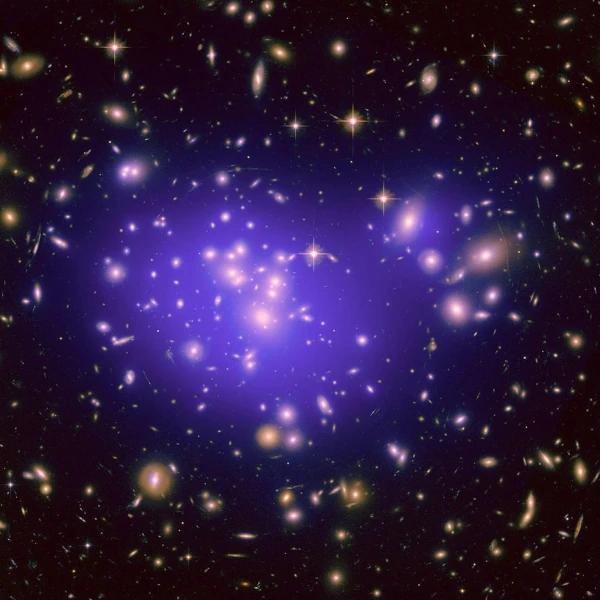
Image description: With a mass equivalent to 1 quadrillion suns, Abell 1689 bends light so strongly it creates cosmic mirages of galaxies up to 13 billion light-years away. Its observations helped constrain dark energy properties and test general relativity on large scales. Image source: NASA/Hubble Space Telescope – Public domain.